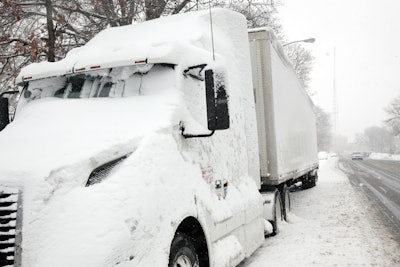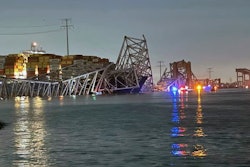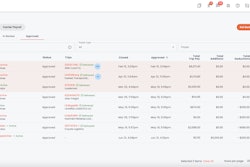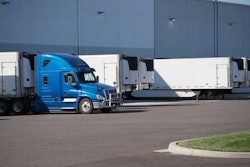
A nuclear verdict case in Texas was upheld earlier this year following a 2014 accident involving a Werner Enterprises commercial truck that resulted in the death of two children when the pickup truck they were riding in lost control and spun into the path of oncoming traffic because of ice on the roadway. Though the tractor-trailer was going 25 miles per hour below the speed limit, the court said the professional truck driver did not reduce his speed by an adequate amount to compensate for the weather.
According to the Federal Motor Carrier Safety Administration, weather or environmental issues cause 3% of large truck accidents in the United States. Weather also poses a number of other issues for motor carriers from maintenance impacts to shipment delays, which is why more and more carriers – and the technology vendors that serve them – are integrating weather into their platforms.
One such example is Nebraska-based K&B Transportation.
The perishable food products transporter has seen an 80% decrease in DOT recordable accidents, and about the same decrease in insurance claims for weather-related accidents, since customizing communications within its driver app to relay weather-related safety risks to drivers. K&B and Eleos integration partner Add On System (AOS) tailored the app to deliver real-time weather alerts using geofencing to provide guidance to drivers during poor weather conditions, whether that be to slow down or to shut down their truck entirely when they enter a risky area.
[RELATED: Drivewyze launches severe weather alerts on Safety+ platform]
“When a truck crosses into a certain zone type, it does two things: it triggers an alert on their tablet … and says ‘Warning, you've entered a zone where we're going to stop travel … Please find a spot to park within the next 20 miles,’” said Matt Fengler, an operations supervisor at K&B. “The second half of that alert … we put in a different dashboard completely, so what the driver sees on the dashboard changes … When that dashboard changes out, their load information goes away because we don’t want them to just go back to the navigation and continue driving anyway. It's like, ‘Hey, this is important. We need compliance. We need to be parked. We need to be safe.’”
Fengler said K&B only had one incident in the past year within the zones that were identified as risky. A gust of wind blew one truck off the shoulder of the road in a single-vehicle incident that resulted in zero injuries and minimal damage, he said. He said the weather alerts have helped K&B improve customer relations as well because they prevent accidents that can cause delays and the company can more effectively communicate ETAs of shipments when weather events occur along a specific route.
“We're able to be more proactive than reactive to weather now, which is huge in our industry,” Fengler said.
He said prior to adding this feature, if a weather event happened on a Saturday afternoon, for example, he would have to gather a skeleton crew in the operations room to call 50 to 60 drivers on the phone and tell them to get parked. It was neither efficient nor effective as most drivers wouldn’t answer while driving.
Benefits beyond safety
Many carriers are still operating in this antiquated manner, said Ben Weisen, president of freight management software provider Carrier Logistics Inc., which recently integrated with weather intelligence platform WeatherOptics that translates weather data into actionable insights for transportation companies.
With today’s technology, that shouldn’t be the case, he said.
“Technology has been focused over the years on attempting to automate as many aspects of supply chain and logistics as can possibly be automated … The constant challenge we experience from the perspective of the motor carriers, and from the perspective of the shippers, is around disruptions and … weather is a major disruptor, but we can predict weather,” Weisen said. “Everything's online. Everything's automated. Everything's connected.
“Yet, these events that aren't totally unexpected sort of take everyone by surprise when it comes to tracking and tracing; when it comes to predicted arrival times; when it comes to making operational decisions. Should I release a truck? Should I hold a truck? Should I change a schedule,” he added. “We said, ‘That just doesn't make sense.’ We all know how to look at a weather map, understand that there's an event occurring and plan around it. Why can't we bring that same logic, that same human intelligence, create an artificial intelligence and add it to the application?”
CLI is currently developing a toolkit to allow its customers to pull information from WeatherOptics into its FACTS software so they can get ahead of potential weather-related delays, allowing them to plan predictively, adjust ETAs, reroute drivers and alert customers when plans need to change.
Weisen said adding the weather element goes beyond enhancing safety to lowering costs, boosting productivity and improving customer satisfaction.
[RELATED: Distance Trucking leans on tech to limit severe weather surprises]
The transportation and logistics industry loses billions of vehicle hours and dollars every year due to weather delays, according to WeatherOptics. A significant amount of those losses can be avoided by understanding the weather along each part of a route and knowing where to expect slowdowns.
“I probably know when a blizzard has actually hit Chicago because then it hits the news, but I probably don't know two days, three days ahead of time that they're expecting a major weather event. The TMS is able now to bring in that weather and merge it with the planning, the coordination and the execution of the freight moves,” Weisen said. “It makes a lot of sense not to find out afterwards that the shipment didn't make it on time but to plan ahead and say ‘Maybe I do need to ship that a day earlier. Maybe I need to change the mode. Maybe I need to just temper my expectations and recognize it's going to get there late and start planning around that.”
He said integrating weather alerts enables fleet managers to communicate better with customers and gives them the opportunity to find a way to use their assets more effectively amid weather disruptions.
Using WeatherOptics, CLI can tell its users how delayed their shipment is going to be, if there are better routing options and the impact of the weather on their driver. Like K&B’s feature, WeatherOptics can also be used to alert drivers of weather conditions in real time.
“But we also allow you to do that out to seven days,” said WeatherOptics Founder and CEO Scott Pecoriello. “So someone can basically have a route planned and see that in three days my driver is going to be at risk of a severe thunderstorm.”
He said WeatherOptics pulls weather model data from typical sources like the government and other agencies that most every company uses, but where WeatherOptics differs is it looks at potential biases or work issues with the models and corrects them automatically, minute by minute, to make it more accurate. WeatherOptics also takes into consideration a multitude of non-weather data, too, like topography, tree density and historic information on how trucks have performed during different types of weather, he said.
While that data helps predict delays and safety risks, Pecoriello said it can also help with pricing based on how weather will impact capacity.
“I think predicted weather and predicted disruption will play a big role in that dynamic pricing model,” Weisen said. “We can discourage freight in lanes that are going to be very difficult to navigate due to weather and likely disruptions, encourage freight in the lanes that are not going to be as impacted or won't be impacted at all, and if we do absolutely have to move something through a lane that's likely to be disrupted by weather, at least the rates will effectively cover the increased expense of the delay.”










